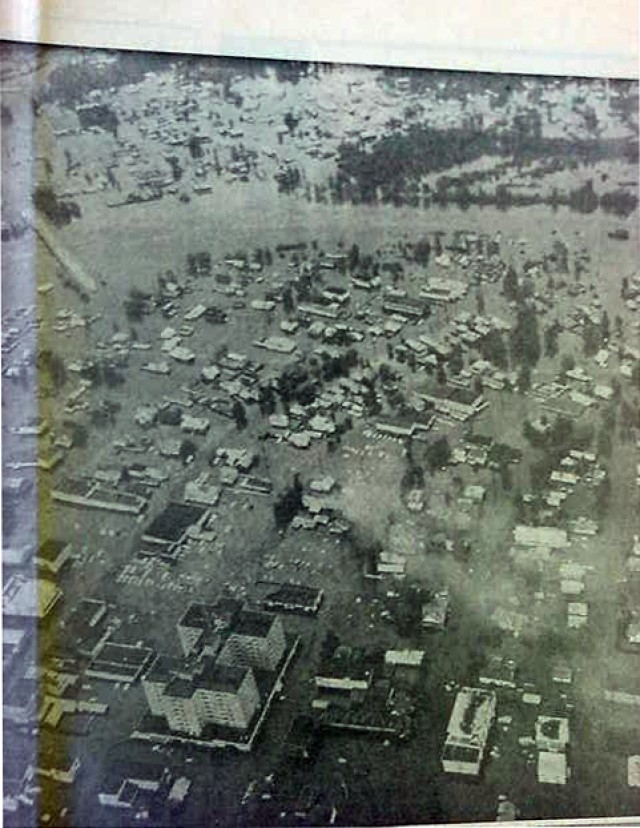FORT WAINWRIGHT, Alaska - Editor's note: The 70th Anniversary and celebration of Ladd Army Airfield scheduled for July 17 is rapidly approaching. Over the next few weeks the Alaska Post, with information compiled by Mike Ferguson and other resources, will lay the foundation of what transpired over the years to bring us to where we are today.
Part 1 described what happened between 1930 and 1940. Congress realized the need for a strategic location at the top of the world, the importance of learning how to operate under extreme conditions and how Ladd Army Airfield was built in just over a year.
Part 2 explained the dividends of cold- weather testing and how Ladd Army Airfield along with the Lend-Lease activities, played a pivotal role in a campaign by the U.S. to help the Soviet Union battle Hitler.
Part 3 covered the end of World War II, the start of the cold war era, the establishment of the U.S. Air Force and the subsequent name change to Ladd Air Force Base. After the Alaskan Air Command was unable to lengthen the runway, which was restricted by the Chena River on both ends, it began moving alert bomber operations to Eielson Air Force Base, 26 miles south. The Army then resumed control of the installation and renamed it Fort Wainwright and it became home to the 12th Aviation Battalion helicopters and fixed-wing aircraft. A section of the post also became home to the Bureau of Land Management as a base for fire-fighting aircraft.
Part 4: Humanitarian support:
In 1964 elements of the 12th Aviation Company deployed south to Fort Richardson and Elmendorf AFB to assist the community of Anchorage in the aftermath of the strongest recorded earthquake in history. The earthquake measured 9.2 on the Richter scale, which virtually destroyed the entire downtown area. In August 1967, Fort Wainwright and its ground and aviation assets assisted the community of Fairbanks in the aftermath of its worst recorded flood in 66 years (6.5 feet above flood stage). Military boats and aircraft rescued untold numbers of people from rooftops and high ground, and transported them to hospitals, shelters and relief centers.
The post, also built in the Chena River flood plain, was covered by the muddy waters from the swollen river. The airfield runways, taxiways, roadways and many buildings were under water. A major problem during recovery was pumping water from miles of utilidors, which are large concrete underground tunnels containing utility lines and steam pipes.
In June 1973 the 222nd Aviation Battalion was transferred from Vietnam to Fort Wainwright to support the 172nd Separate Infantry Brigade which was constituted for global deployment as an Initial Expeditionary Force. The 222nd was the largest and most diverse aviation battalion in the Army. It had a CH-47 Chinook Company, a CH-54 Skycrane Company and an OV-1 Mohawk MI Company. Later Troop E (Air), 1st Cavalry was added with AH-1 Cobras and OH-58 Kiowas to provide brigade reconnaissance and security. UH-l Hueys were added for medical evacuation and general support.
During 1974 through 1979, Fort Wainwright became a management center for the Trans-Alaska oil pipeline construction project: an 800-mile long, 48-inch diameter steel pipeline from Prudhoe Bay to Valdez. Surplus buildings on the north post were converted into construction headquarters for the interior portion of the pipeline project. More than 500 project management personnel worked there and lived in Fairbanks. In addition, a construction camp was located on Fort Wainwright which housed 1,164 workers.
In 1984, the airfield and its early hangars and buildings were declared a National Historic Landmark by the Department of the Interior. Even though it was named Wainwright Army Airfield at the time, it was entered into the National Historic Register as Ladd Field in recognition mostly of its role in the WWII Russian Lend-Lease operation.
In March 1986, the 172nd Infantry Brigade was deactivated and replaced by the 6th Infantry Division. In April, the 222nd Aviation Battalion was deactivated and replaced by the 6th Combat Aviation Brigade. The Division's mission was to prepare to deploy rapidly worldwide in support of U.S. national objectives and to defend Alaska.
The 6th Aviation Brigade was based on Wainwright Army Airfield and consisted of three subordinate units: 4th Battalion, 123rd Aviation Regiment, 4th Squadron, 9th Cavalry Regiment and the 1st Battalion, 3rd Cavalry based in Minneapolis, Minnesota, which was tasked to augment in case of Brigade deployment. At its peak, the Brigade had over 80 aircraft. The Brigade's heavy lift CH-47 and general support UH-1 were additionally tasked to support the Air Force Technical Applications Center mission to detect, locate and classify underground nuclear tests in the Asian Far East. The Chinooks and Hueys provided logistics support to the radio-isotope generators and the sensitive, deep seismographs that were deployed in the vicinity of Burnt Mountain, north of Fort Yukon. The mission was declassified after it became a United Nations treaty compliance issue.


Social Sharing